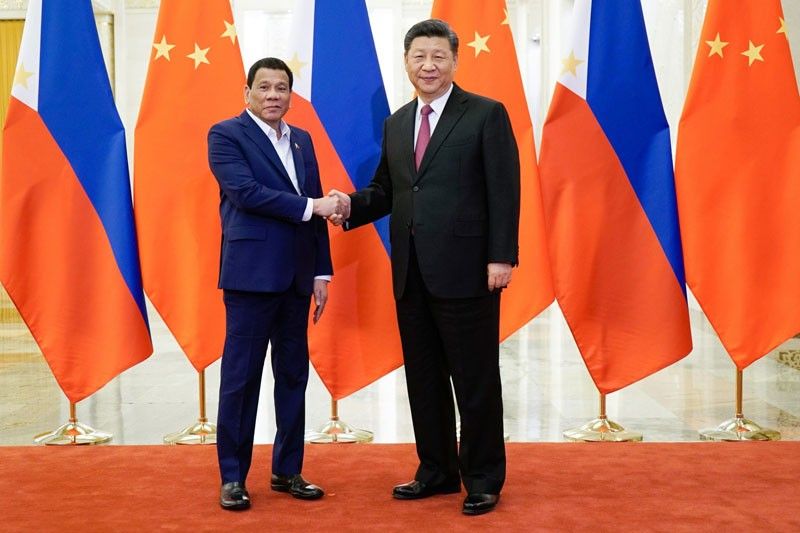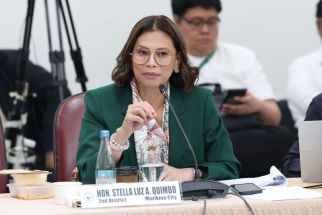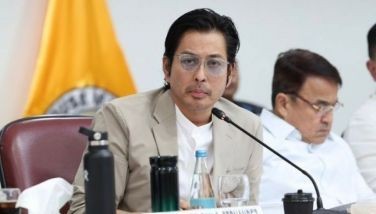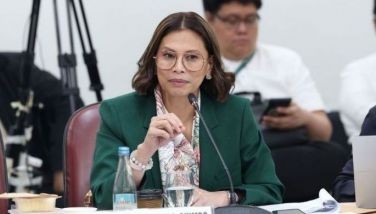China-Philippines ties getting better and better – Xi

BEIJING – For Chinese President Xi Jinping, relations between the Philippines and China are getting stronger and better.
“We are happy to see Philippines-China relations getting better and better. The cooperation between the two sides is very good and getting stronger,” Xi said in his opening statement at a bilateral meeting with President Duterte at the Great Hall of the People here yesterday.
Duterte is joining at least 40 heads of government, including Russian President Vladimir Putin, as well as leaders of international organizations for the Second Belt and Road Forum in this Chinese capital. Duterte was among 14 leaders that Xi met for bilateral talks yesterday.
Duterte also met with Chinese Premier Li Keqiang for separate talks at dinner.
Xi said he thought highly of the Philippines, especially regarding the task of fostering maritime cooperation and in the Belt and Road Initiative that he started in 2013.
“I think this forum will promote the relationship between the two countries. I think high of China-Philippines relationship as very important,” the Chinese president added.
He also said he treats Duterte as his best friend and trusted partner. He recalled meeting with Duterte twice last year – at the Boao Forum in China and in his state visit to Manila in November.
“We both planned the future of our relations,” Xi said of his meetings with the Philippine leader.
Duterte has been pursuing a policy of appeasement of China since becoming president in 2016 – despite China’s provocative activities in the West Philippine Sea, including seizure of many land features clearly within Philippine territory.
The Philippine leader raised the 2016 ruling of an arbitral court on the South China Sea issue, but the issue was apparently not discussed extensively as the meeting did not take long.
In his remarks, Duterte stressed the importance of the ongoing Second Belt and Road Forum in renewing the relations with China based on mutual trust, respect and friendship.
“I would like to greet China on its 70th founding anniversary as China celebrates the significant milestone, the Philippines congratulates China on its economic achievements,” the President said.
Duterte pointed out that the Philippines and China must continue to work together to explore new areas of cooperation and partnership.
“We look forward to a productive discussion on matters of mutual interest and concern,” he said.
“We listen to His Excellency’s talks and progress, achieved in further strengthening bilateral relations in the recent development in our region.”
He also described Xi’s visit to Manila last November as a watershed moment in Philippines-China ties.
“The decision to elevate bilateral ties to a comprehensive, strategic cooperation affirms the Philippines’ and China’s strong desire to further deepen and broaden this engagement,” Duterte added.
He also said the Philippines is starting to enjoy the fruits of Xi’s visit.
“We envision high quality and good impact projects. The sooner they are completed, the sooner people on the ground will feel the benefits of Philippines-China relations,” Duterte said.
Duterte also said the presence of over 35 leaders and heads of international organizations in the Second Belt and Road was a demonstration of the global community’s trust and confidence in China’s forum.
Dispute not everything
On Wednesday at the Philippine embassy here, Ambassador Jose Sta. Romana told reporters the administration has skillfully managed its relations with China notwithstanding disputes.
“As you know our bilateral relations with China consist of two general areas – the disputes and the areas where there are no disputes, the disputes do not define everything, they are only part of the overall picture. So where there are no disputes like trade, economic, science, cultural, we are able to fast-track,” he said at a press briefing.
“Where there are disputes, we discuss through diplomatic channels, through the bilateral consultative mechanism (BCM),” he pointed out.
“And the issue for example of the Pag-asa, Scarborough Shoal, Panatag Shoal, the issue of the giant clam, the swarming, these were discussed extensively during the last BCM,” Sta. Romana emphasized.
Despite opposing views on some issues, Sta. Romana said the two countries have not strayed from the path of negotiations.
“And although it was a very contentious issue, there were differences in views, we have different positions with the Chinese, both sides agreed to resolve this issue through diplomatic negotiations so that the basic approach is to discuss the disputes and manage it so that they will not turn into a crisis,” he pointed out.
Sta. Romana also said the Philippines’ participation in the Belt and Road Initiative soon after its launch in 2013 was a major policy move aimed at boosting infrastructure and facilitating free trade, financial integration and people-to-people exchanges.
“The Philippines being in the Belt and Road could also look at the economic and investment potentials as a result of its participation in it,” the ambassador said.
He acknowledged the maritime dispute between the Philippines and China remains a thorny issue.
“Our position is Kalayaan Island Group belongs to the Philippines, the Chinese position is opposite, they claim all of the Spratlys. So, we have basic differences, so that we have agreed that we will deal with these differences through peaceful diplomatic means,” he added.
But he stressed Beijing has committed not to occupy Pag-asa Island or use force to wrest it from the Philippines.
“They have assured us. But you know, the diplomatic action is take them on their word but verify and keep your vigilance – trust but verify,” he said.
“This is our attitude, we welcome any reassurance that there won’t be any act of force against our people, against our soldiers but at the same time, we have to remain vigilant,” the ambassador added.
Sta. Romana also said the government combines diplomacy with deterrence.
“The Chinese have also given reassurance that the traditional fishing rights of Filipino fishermen there will be safeguarded together with those of the Chinese,” he said. “Here you really have to, you know, working in close quarters… the real issue here is how to avoid any miscalculation.
“How to avoid any conflict and how to de-escalate and how to exercise restraint so the issue will not become crisis and so that it will not become a situation that will not distract the positive trajectory of the relations,” Sta. Romana further explained.
In 2016, the UN-backed Permanent Court of Arbitration invalidated China’s massive nine-dash line claim in the South China Sea and reaffirmed the Philippines’ own maritime entitlements. China has vowed not to comply with the ruling.
Illegal workers
Meanwhile, he said the Philippines – through the Department of Labor and Employment, Department of Tourism and Bureau of Immigration – has to do something about the influx of Chinese illegally working in the country.
“The issue of illegal or Chinese presence in the Philippines is an issue we should – that is also subject to, you know, you have to… If it’s illegal, you have to crack down on what’s illegal. If there are loopholes, you have to plug the loopholes, OK. We are encouraging tourism right now, so we issue tourist visas here. But they are stamped not for employment, somehow,” Sta. Romana said.
The ambassador said he met with Labor Secretary Silvestre Bello III in Beijing the other day and that they both agreed that something has to be done about the problem.
“Yes, there is a problem that has to be solved. I just had discussion with Secretary Bello,” he said.
He admitted many of the Chinese workers entered the country as tourists beginning in 2016.
“In 2016, there were around 600,000 Chinese tourists in the Philippines. We were able to achieve one million in 2017 and in 2018, it became 1.25 million,” Sta. Romana told reporters.
Of the 7.1 million tourist arrivals last year, the Chinese account for 1.2 million – representing the second biggest next to South Korea.
He attributed the increase in the number of Chinese tourists in the Philippines to the aggressive drive of the DOT as well as China’s lifting of some travel restrictions for its citizens.
Sta. Romana said that tour agencies should be properly accredited, especially those bringing groups of Chinese tourists.
“These tour agencies who bring the tourists into the Philippines should also be able to bring them back to China, in that way those tourists could not get work permits and stay longer in the country,” Sta. Romana added.
- Latest
- Trending





























